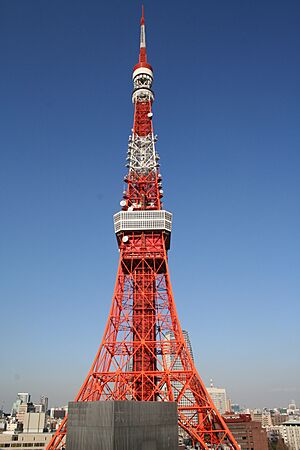Tachū Naitō facts for kids
Tachū Naitō (born June 12, 1886 – died August 25, 1970) was a brilliant Japanese architect and engineer. He is known as the "father of earthquake-proof design" because he created new ways to make buildings safe during earthquakes. He designed many tall structures, including famous broadcasting and observation towers like the Tokyo Tower.
Contents
Early Life and Education
Tachū Naitō was born on June 12, 1886. His hometown was Minami-Alps, in the Yamanashi Prefecture of Japan.
He went to the Old System Kofu Middle School. Later, he attended the Tokyo Imperial University, which is now known as the University of Tokyo. Naitō first started studying how to build ships. However, he changed his focus to architecture. This was because there was less work in shipbuilding after the Russo-Japanese War. He finished his studies in 1910. In 1913, he became a professor at Waseda University.
Inventing Earthquake-Proof Design
In 1916, Naitō traveled to America to study. During this trip, he came up with his important idea for earthquake-proof walls. He was riding on the First transcontinental railroad when he noticed something interesting. When the train stopped suddenly, luggage in the compartment would slide and get messy. There were no walls or dividers to keep the bags in place.
This observation gave him an idea. He thought that if buildings had strong internal walls, they could resist the shaking of an earthquake. These special walls are now called shear walls. They help a building stand strong during ground movement.
Proving His Ideas
Naitō used his new earthquake-proof design theory on a major building. This was the main office for the Industrial Bank of Japan. Another architect, Setsu Watanabe, designed the building.
Just three months after the building was finished in 1923, a huge earthquake hit. This was the Great Kantō earthquake, one of the strongest in Japanese history. Naitō's building stood strong and was not badly damaged. This proved that his earthquake-proof design worked! He often shared this success story in his lectures.
Famous Towers and Buildings
Besides the Industrial Bank of Japan, Naitō also worked on other important buildings like the Kabuki-za theater and the Okuma auditorium.
He is most famous for designing many tall broadcasting and observation towers across Japan. These include:
- The Nagoya TV Tower (built in 1954)
- The Tsutenkaku tower (built in 1956)
- The Sapporo TV Tower (built in 1957)
- The Beppu Tower (built in 1957)
- The iconic Tokyo Tower (built in 1958)
Awards and Recognition
Throughout his career, Tachū Naitō held many important positions and received several awards.
- In 1938, he became the head of the Japan Welding Society.
- In 1941, he led the Architectural Institute of Japan.
- In 1954, he became a member of the Science Council of Japan.
- He joined the Japan Academy in 1960.
- In 1962, he was given a special award for his cultural contributions.
- In 1964, he received the second-class Order of the Rising Sun, a high honor in Japan.
Later Life
Tachū Naitō passed away on August 25, 1970, at the age of 84. He died in a hospital in Tokyo. His resting place is in the Naitō family graveyard at Tamareien Cemetery. A bronze statue of him stands there, next to his epitaph.
Images for kids





